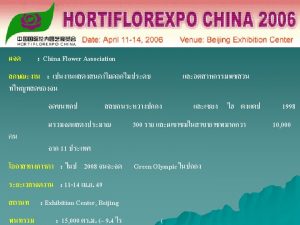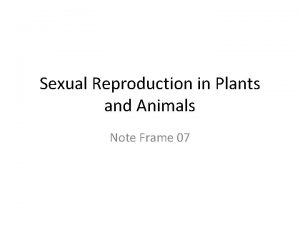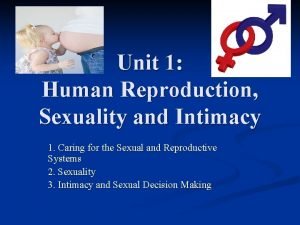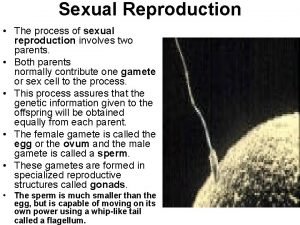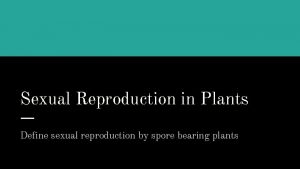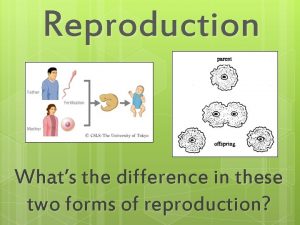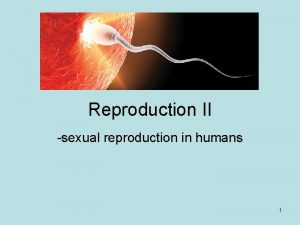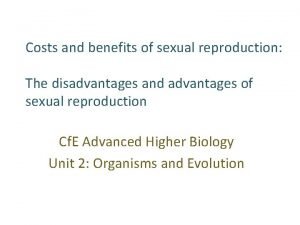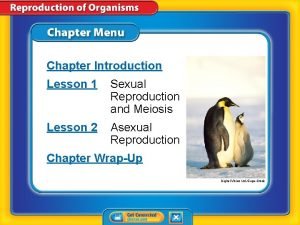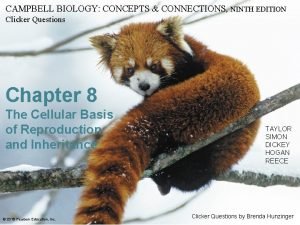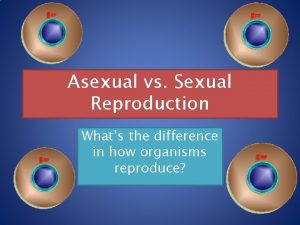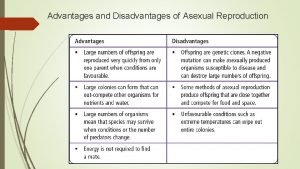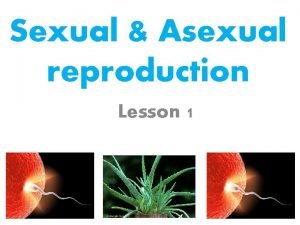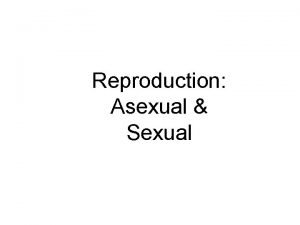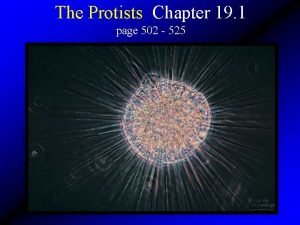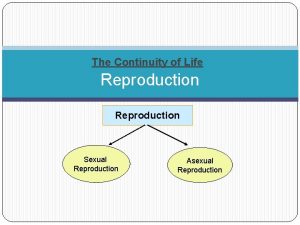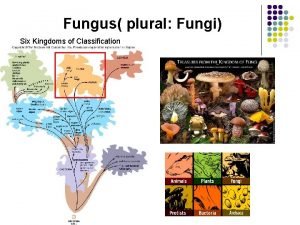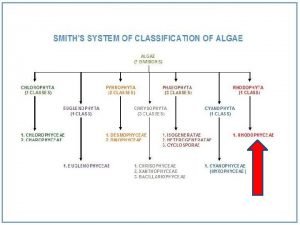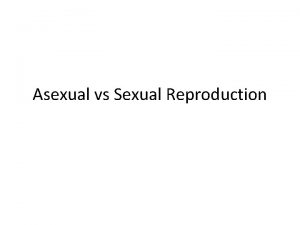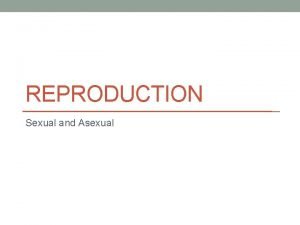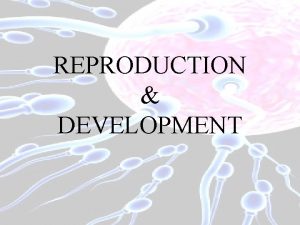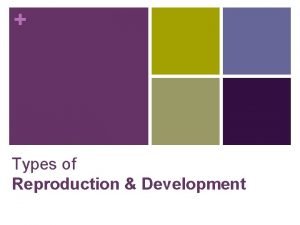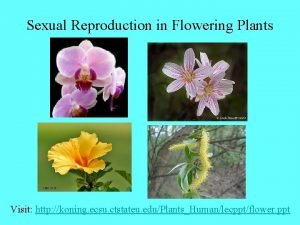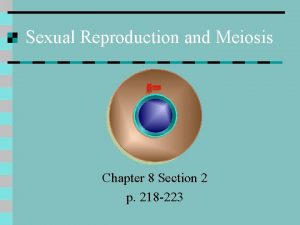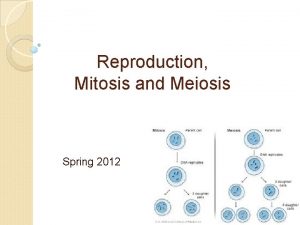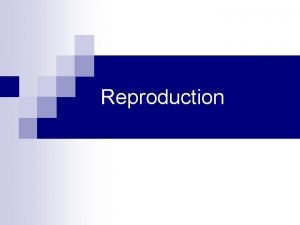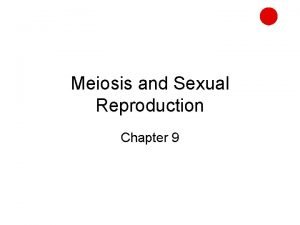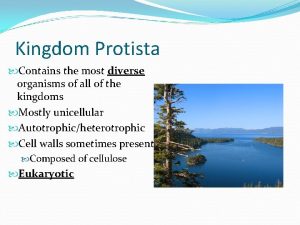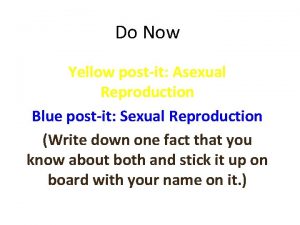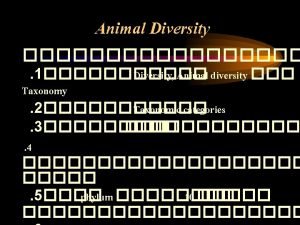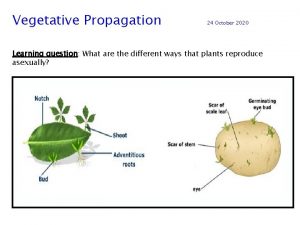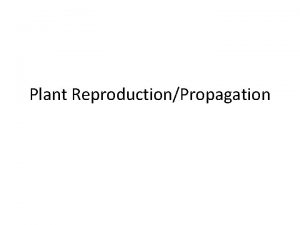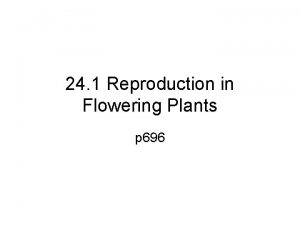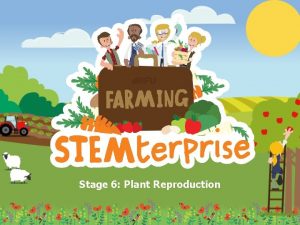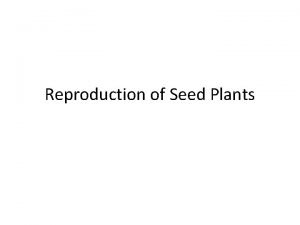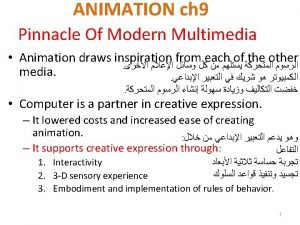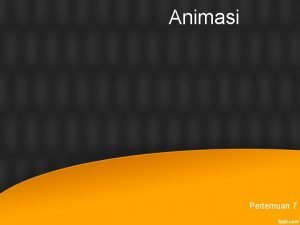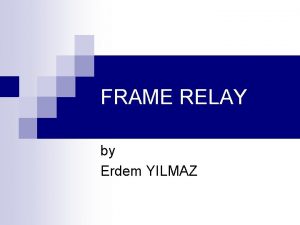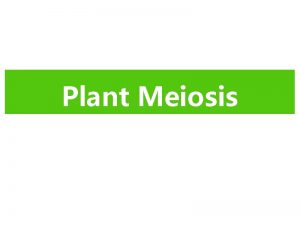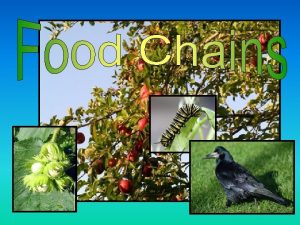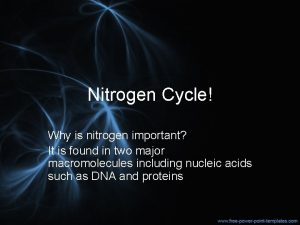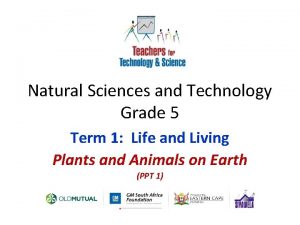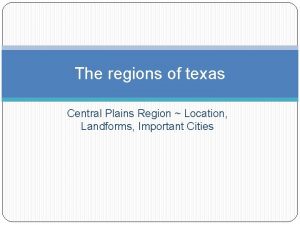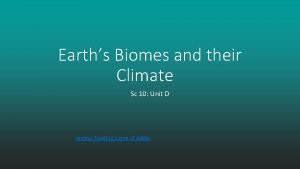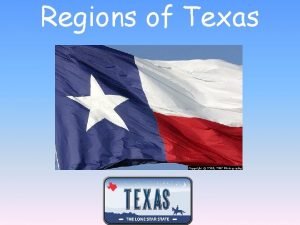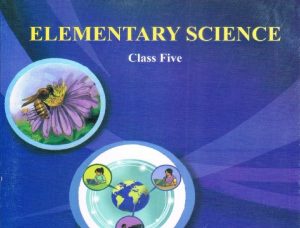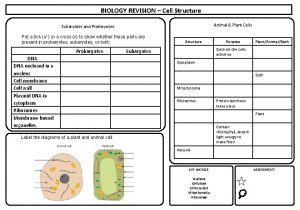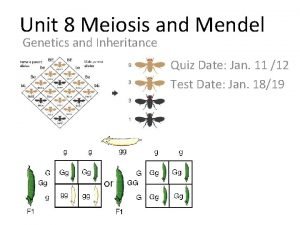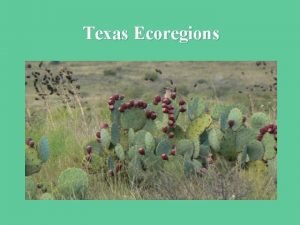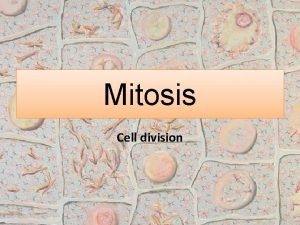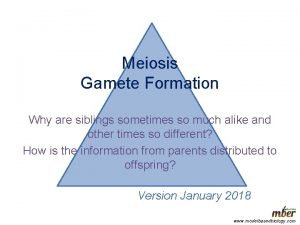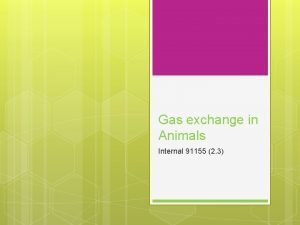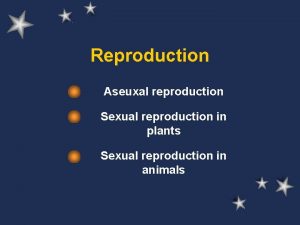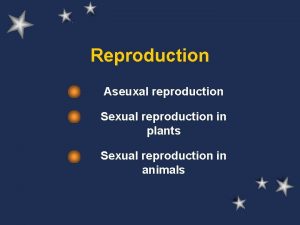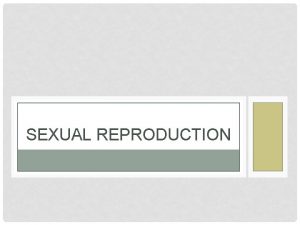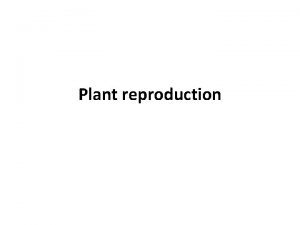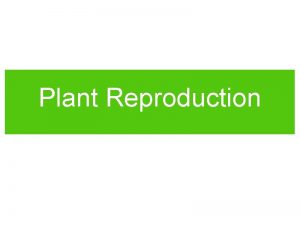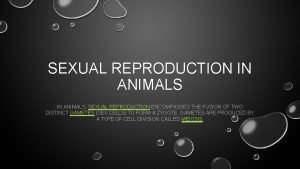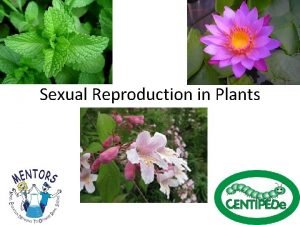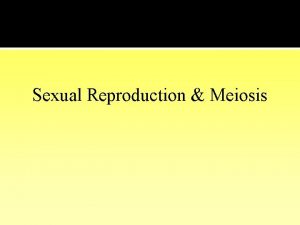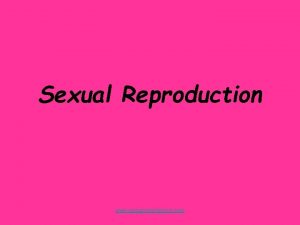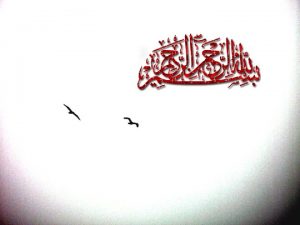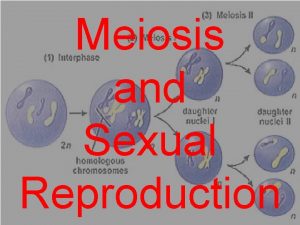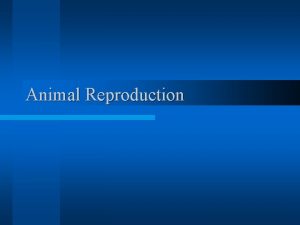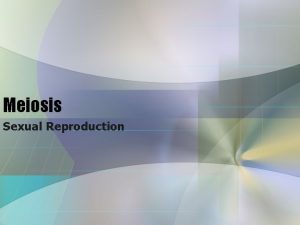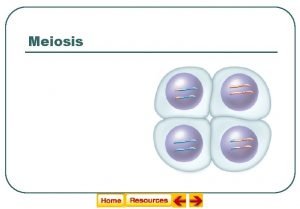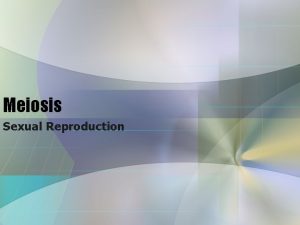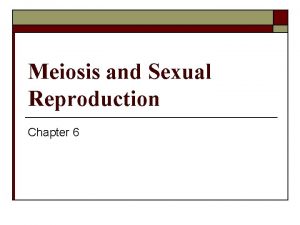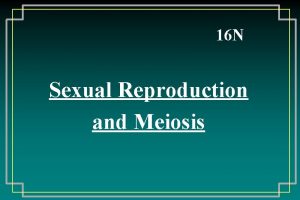Sexual Reproduction in Plants and Animals Note Frame
























































































- Slides: 88

Sexual Reproduction in Plants and Animals Note Frame 07

Key Terms • Stamen • Sperm • Gonads • Pollen • Physical adaptation • Pistil • Embryo • Ovary • Testes • Behavioural adaptation

Sexual Reproduction • Gonads – reproductive organs –Produce gametes –Male gonad = testes –Female gonad = ovaries

Spermatogenesis • Male gonad = testes –Produces specialized reproductive cells • sperm • Spermatogenesis – process that makes sperm

Spermatogenesis

Oogenesis • Female gonad = ovary –Produces specialized reproductive cells • ovum (egg) • Oogenesis – process that makes ovum –Only one egg cell receives enough cytoplasm to survive

Oogenesis Only one egg cell receives enough cytoplasm to survive

• Oogenesis produces 1 egg cell (ovum) and 3 polar bodies –polar bodies in humans cannot be fertilized


Fertilization • Meiosis is necessary for gametes to be produced • After fertilization: –Mitosis is used for growth of the zygote (single cell) –Zygote needs food, moisture, warmth and protection


• Zygote will grow and develop –Next stage of development is embryo • Embryo also develops and matures through mitosis

Types of Fertilization 1. Internal Fertilization • When the egg and sperm combine inside the body –Example: humans, dogs, etc. • Most organisms on land reproduce through internal fertilization

• Requires male to have specialized structure to transfer sperm directly into female Advantages • Very successful • Fewer gametes required Disadvantages • Requires more energy (especially from female)

2. External Fertilization • When the egg and sperm combine outside body –Example: frogs, fish, corals, etc. • Most sea life reproduce through external fertilization • Release eggs and sperm into the water

• Types of animals with external fertilization –Free-swimming animals (ex: fish) • Lay eggs in a cluster, male will release sperm onto the egg cluster –Stationary organisms (ex: coral) • Rely on water currents to bring gametes together

Advantages • Does not require as much energy Disadvantages • It is not safe –Predators • More gametes needed (not all likely to meet) External fertilization: Salmon spawning https: //www. youtube. com/watch? v=SOll UTBYZt. E

Plant Anatomy • Plants produce by sexual reproduction using male and female gametes –Pollen – male gamete • Found on stamen –Ovum – female gamete • Found on pistil

• Plants have reproductive structures –Stamen – male reproductive structure –Pistil – female reproductive structure

Anther Stamen (Male) Filament Petal Stigma Pistil Style (Female) Ovary Sepal Ovule (egg)

Pollination = Fertilization • Pollen (male gamete) is transferred to pistil (female reproductive structure) • Fertilizes many eggs (ovules) –Produces zygotes –Zygotes develop into seeds –Ovary develops into fruit


Adaptations are anything that helps survival and the reproductive success of plants and animals • Sexual reproduction produces variation in offspring – ex: differences • Make sure that best genetics are passed on to next generation –Ex: “Only the strong survive”

Animal Adaptations • Can be physical adaptations –Changes over time to animal bodies (colour, size, limbs, etc. ) to help survive environments and reproduce • Can be behavioural adaptations –Changes over time to the way an animal acts to help survive environments and reproduce

Physical or Behavioural Adaptation? Penguins live in large groups Behavioural

Stick bug looks like a leaf Physical

Bears hibernate in the winter Behavioural

Kangaroos have muscular legs to travel by jumping Physical

Cuckoo birds lay their eggs in other bird’s nests (Red warbler feeding Cuckoo baby!) Behavioural

Bactrian camel stores fat and water Physical

Ground squirrels bury and store their food for winter Behavioural

Musk ox has thick shaggy hair to protect from -40 -50 degrees C Physical

Mothers care for young offspring Behavioural

Puffer fish can expand to twice its size so it can’t be eaten Physical

Birds do a mating dance to attract a female Behavioural

Male and female peacocks are very different looking (sexual dimorphism) Physical

Snakes moult their skin Physical

Geese migrate south in the fall Behavioural

Sloths have long claws that allow them to climb and hang on trees Physical

A single elephant seal mates with multiple females (polygynous) Behavioural

Angler fish have a phosphorescent light organ to attract prey Physical

Bald eagles mate for life (pair bonding) Behavioural

Turtles are adapted to swimming in the ocean Physical

Further reading: http: //www. bbc. co. uk/nature/adapt ations http: //www. animalplanet. com/wildanimals/resource-conservation/

Plant Adaptations • Plants only have physical adaptations for their environments –Plants do not have behaviours Adaptations to desert environments • Cactus has spines instead of leaves (uses less water) • Cactus stores water in its stem • Cactus with hair to provide shade


• Waxy coating on leaves to prevent water loss

Adaptations to prairie environments • Plants grow soft stems to bend in the wind • Thick bark on trees to resist fires • Fruit will be wind pollinated • Extensive root systems to absorb all moisture • Narrow leaves on plants to loose less water




Adaptations to tundra environments • Plants are usually very short – being close to the ground keeps them from freezing • Plants are darker in colour – help absorb solar heat • Plants grow in clumps to help protect from wind and cold


Fruit Adaptations • Fruit are the ovaries of plants • Plants have adaptions to help with seed dispersal –Spreading seeds to new locations • Animal dispersal • Wind dispersal • Water dispersal

Animal dispersal • Seeds can cling to animals –Burrs have barbs to stick to fur • Seeds grow in sweet, fleshy fruit –Animals eat fruit and defecate seeds in new location –Animals bury fruit

Wind dispersal • Seeds are hair-like or feather-like structures –Adapted to float in the wind to new locations

Water dispersal • Plants that grow near water have fruit/seeds that float

Asexual Reproduction One parent Sexual Reproduction Two parents Mitosis - daughter cells Meiosis - gametes Two offspring One offspring Genetically identical to parent. Combination of both parents genes. No variation unless due to mutations. High variation due to gamete production and fertilization.

Asexual Reproduction Advantages Disadvantages No need to find a partner Less chance for evolution Less energy is required to reproduce. Genetically identical organisms are more Offspring are well adapted vulnerable to disappearing to the environment because of a catastrophe or because of the success of disease. the parent. Fast – can take over an area quickly by reproducing. Can lead to overcrowding and competition for survival.

Sexual Reproduction Advantages Disadvantages Slow – finding a partner and Two parents to watch over producing gametes takes offspring time. Increases genetic variation Lots of energy used to make in a species - more gametes and attract a mate. evolution Variations guarantee that a higher proportion will survive in cases of catastrophe or disease. The genetic results of meiosis and often fertilization, are unpredictable

Sexual Reproduction (continued) Advantages Disadvantages Only the “strongest ” will be able to reproduce allowing the best qualities to be passed on to new generations. Genetic "errors" happen more frequently because meiosis is more complex than mitosis.

Human Anatomy and Reproduction Note Frame 08

Male Anatomy

Key Terms • Scrotum • Prostate gland • Seminiferous tubules • Penis • Testes • Epididymis • Semen • Urethra • Seminal vesicle • Cowper’s gland • Vas deferens

Male Reproductive System Purpose: • To produce sperm • Pass sperm on to female –Through sexual intercourse

Male Anatomy Seminal Vesicle Prostate Cowper’s Gland Epididymus Testes Bladder Vas Deferens Penis Urethra Scrotum

Anatomy and Function Scrotum • Holds the testes externally (outside) • Provides a cooler environment –For making healthy sperm Testes • Contains seminiferous tubules –Tiny tubes that produce 300 -500 million sperm per day

Epididymis • Storage place where sperm are kept until they leave the body Vas deferens • Carries sperm from epididymis to the urethra

Urethra • Carries both sperm and urine through the penis –Bladder has a small valve that stops urine during ejaculation Penis • External organ that is specialized to deliver sperm during sexual intercourse

Prostate gland Seminal vesicle Cowper’s gland • 3 glands together make the fluid called semen –Semen contains nutrients that give sperm the energy to swim from the male and reach the egg in the oviduct

Sperm • Made in the seminiferous tubules in the testes • Stored in the epididymis • Travels through the vas deferens to the urethra • Ejaculated into the female to find the egg

Sperm head: • Contains chromosomes • Contains chemicals for entering the egg Sperm tail: • Provides mobility • Propelling the sperm forward


Spermatogenesis

Female Anatomy

Key Terms • Cervix • Oviduct (fallopian tube) • Ovulation • Endometrium • Uterus • Oocyte • Ovary • Vagina • Follicle cells • Urethra

Female Reproductive System Purpose: • To produce eggs • Nourish and hold zygote until fully developed • Give birth

Female Anatomy Oviduct Ovary Uterus Bladder Urethra Vagina Cervix

Anatomy and Function Vagina • Receives sperm from the male • Acts as birth canal Cervix • Connects vagina to uterus • Directs sperm into uterus during sexual intercourse

Urethra • Carries urine from bladder out Ovary • Location of follicle cells –Follicle cells develop into mature egg cells ready to be fertilized by sperm • Releasing an egg from an ovary is called ovulation

Uterus • Hollow muscular organ • Where the fertilized egg will implant and grow • Lined by the endometrium –Endometrium is blood-rich layer that will nourish and protect fertilized egg

Oviduct • Also known as fallopian tube • Connects ovary to uterus • Where fertilization happens (sperm meets egg) –If no fertilization -- takes the unfertilized egg and transports it to uterus


Egg Cells (Oocytes) • Ovaries contain follicle cells –Follicle cell – is a cell that contains an egg cell (oocyte) • Oocyte develops in the ovary until ovulation –At ovulation the follicle cell bursts and releases the mature egg

Ovarian Cycle

Fertilization • Fertilization takes place in the oviduct • Millions of sperm begin the journal, only a few thousand reach the egg in the oviduct • Only one sperm can fertilize the egg –The first sperm to get through the cell wall of the egg sets off a chemical reaction that stops other sperm from entering the egg


• Fertilized egg lodges into the endometrium in the uterus wall – Where it gets nourishment and protection
 Asexualk
Asexualk Sexual and asexual reproduction venn diagram
Sexual and asexual reproduction venn diagram Asexual vs sexual reproduction venn diagram
Asexual vs sexual reproduction venn diagram Venn diagram sexual and asexual
Venn diagram sexual and asexual Sexual reproduction
Sexual reproduction A sexual reproduction in plants
A sexual reproduction in plants Consumers producers and decomposers
Consumers producers and decomposers Animals that eat both plants and animals
Animals that eat both plants and animals Animals that eat both plants and animals
Animals that eat both plants and animals Sexual reproduction and genetics section 1 meiosis
Sexual reproduction and genetics section 1 meiosis Mendelian genetics
Mendelian genetics Sexual reproduction and genetics section 1 meiosis
Sexual reproduction and genetics section 1 meiosis Mitosis and meiosis
Mitosis and meiosis Venn diagram of meiosis and mitosis
Venn diagram of meiosis and mitosis Chapter 10 sexual reproduction and genetics
Chapter 10 sexual reproduction and genetics Asexual reproduction cell division
Asexual reproduction cell division Sexual reproduction organisms
Sexual reproduction organisms Asexual and sexual reproduction difference
Asexual and sexual reproduction difference Parthenogenesis in mammals
Parthenogenesis in mammals Organisms that reproduce asexually
Organisms that reproduce asexually Sexual reproduction in human
Sexual reproduction in human Definition of reproduction
Definition of reproduction Define sexual reproduction
Define sexual reproduction Whats a sexual reproduction
Whats a sexual reproduction A sexual reproduction in humans
A sexual reproduction in humans Parthenogenesis asexual reproduction
Parthenogenesis asexual reproduction Connecting the concepts sexual reproduction
Connecting the concepts sexual reproduction Biology
Biology Whats asexual reproduction
Whats asexual reproduction Disadvantages of sexual reproduction
Disadvantages of sexual reproduction Significance of sexual reproduction
Significance of sexual reproduction Asexual vs sexual reproduction
Asexual vs sexual reproduction Sexual reproduction in paramecia is called _____.
Sexual reproduction in paramecia is called _____. Sexual or asexual reproduction
Sexual or asexual reproduction Fungus in plural
Fungus in plural Division rhodophyta
Division rhodophyta Sexual or asexual reproduction
Sexual or asexual reproduction Sexual reproduction
Sexual reproduction Asexual or sexual reproduction
Asexual or sexual reproduction Sexual reproduction
Sexual reproduction Requires two parents
Requires two parents Sexual reproduction
Sexual reproduction Sexual reproduction
Sexual reproduction Sexual reproduction definition
Sexual reproduction definition Blastula
Blastula Three groups of protists
Three groups of protists Meiosis ii stages
Meiosis ii stages The kingdom protista contains
The kingdom protista contains Benefits of sexual propagation
Benefits of sexual propagation Anaphase in meiosis vs mitosis
Anaphase in meiosis vs mitosis A sexual reproduction
A sexual reproduction Difference between note making and note taking
Difference between note making and note taking What are signal words
What are signal words Difference between note making and note taking
Difference between note making and note taking Debit note and credit note
Debit note and credit note Debit note meaning
Debit note meaning Note taking and note making
Note taking and note making Cow reproductive anatomy
Cow reproductive anatomy Examples of vegetative propagation
Examples of vegetative propagation Male plant reproductive system
Male plant reproductive system Significance of mitosis and meiosis ppt
Significance of mitosis and meiosis ppt Vascular plants vs nonvascular plants
Vascular plants vs nonvascular plants Female parts of a flower diagram
Female parts of a flower diagram Learning objectives of reproduction in plants
Learning objectives of reproduction in plants Flower ovule
Flower ovule Frame by frame animation programs
Frame by frame animation programs Pengertian animasi frame by frame
Pengertian animasi frame by frame Frame relay frame format
Frame relay frame format What is frame relay
What is frame relay Single vs double crossover
Single vs double crossover Can plants be keystone species
Can plants be keystone species Cloroplasto
Cloroplasto What animals are in temperate deciduous forest
What animals are in temperate deciduous forest Every living plants and animals must have
Every living plants and animals must have Ciclo del fosforo
Ciclo del fosforo Plants and animals on earth grade 5
Plants and animals on earth grade 5 Texas central plains animals
Texas central plains animals Grassland biome animals and plants
Grassland biome animals and plants Subregions of mountains and basins
Subregions of mountains and basins Science class five
Science class five Animal cell diagram biology
Animal cell diagram biology Chromosome number
Chromosome number South texas plains ecoregion
South texas plains ecoregion Differences between mitosis in plants and animals
Differences between mitosis in plants and animals Modelbasedbiology
Modelbasedbiology Gas exchange in plants and animals venn diagram
Gas exchange in plants and animals venn diagram Non flowering plants classification
Non flowering plants classification Financial documents in order
Financial documents in order Simple discount formula
Simple discount formula





